Workplace Discrimination Based on Gender: Marks & Spencer Case Study
VerifiedAdded on 2023/02/01
|33
|6870
|43
Report
AI Summary
This research project investigates workplace gender discrimination, focusing on a case study of Marks & Spencer. The report begins with an overview of the research, background, rationale, aims, objectives, and research questions. It then provides a comprehensive literature review covering workplace discrimination, gender discrimination issues at Marks & Spencer, the benefits of anti-discrimination policies, and strategies to reduce discrimination. The methodology section details the research approach, design, data collection methods, sampling, ethical considerations, and timescales. Data analysis and interpretations are presented, followed by research outcomes, findings for stakeholders, and recommendations for alternative research methodologies. The report concludes with a reflection on the research and provides a list of references.
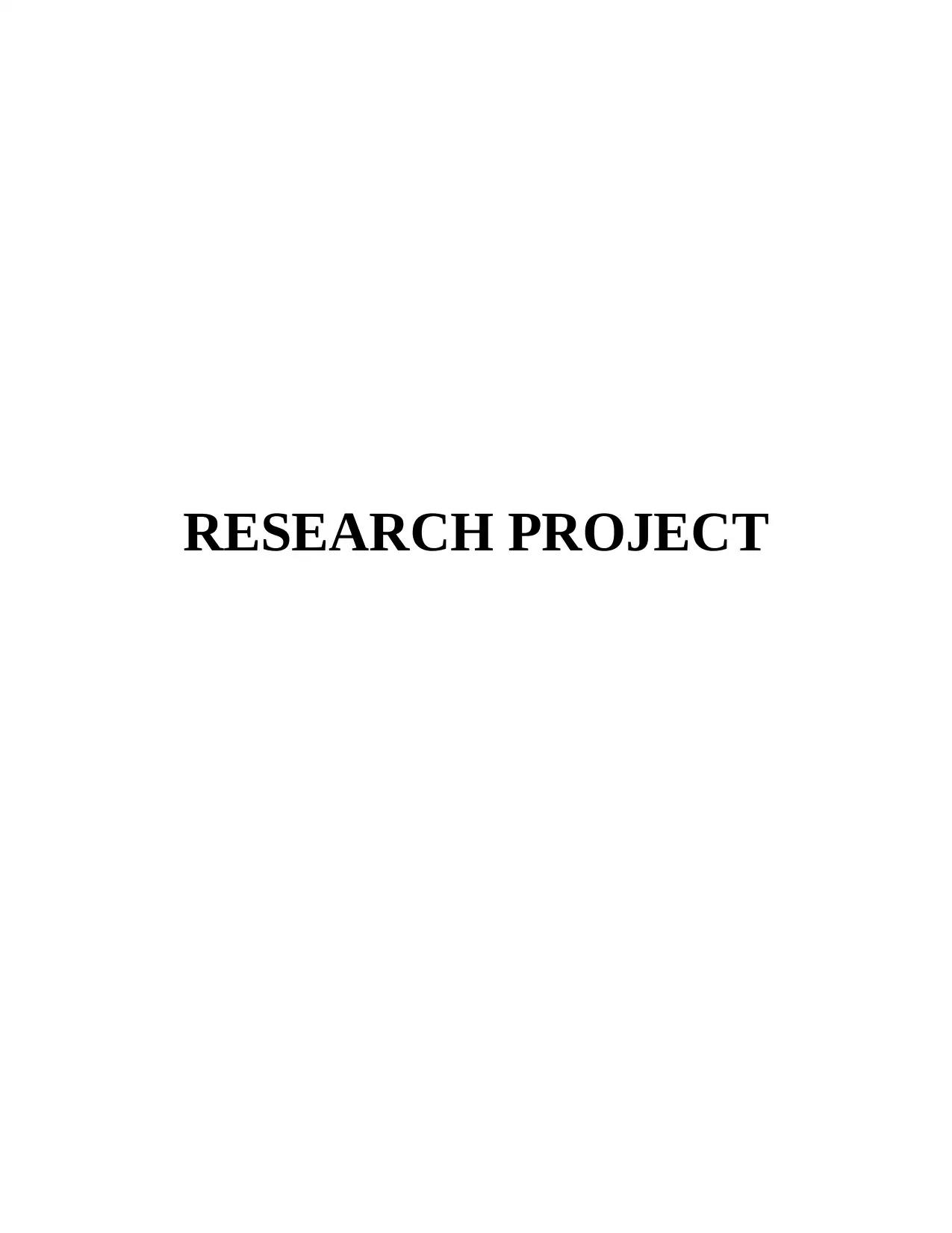
RESEARCH PROJECT
Paraphrase This Document
Need a fresh take? Get an instant paraphrase of this document with our AI Paraphraser
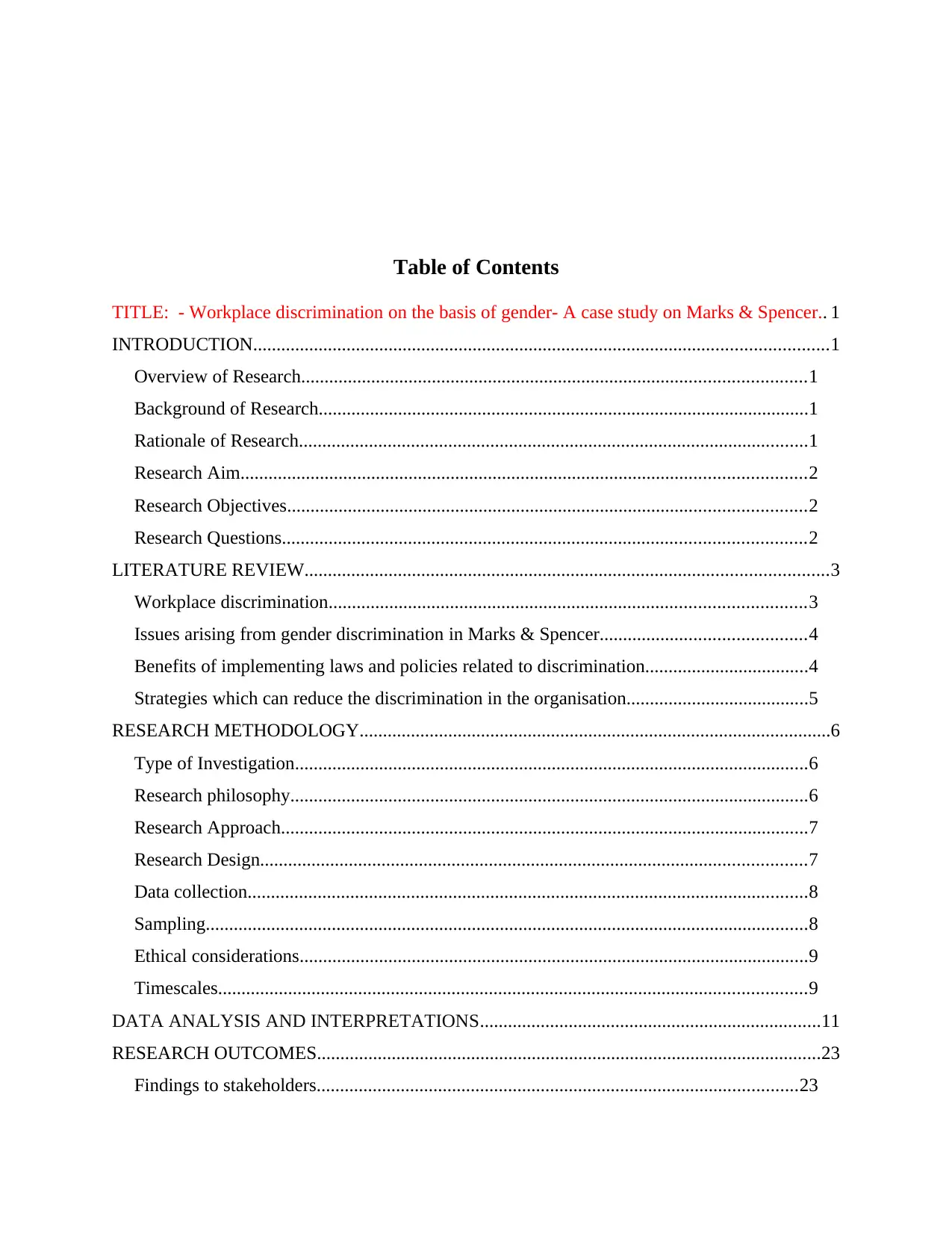
Table of Contents
TITLE: - Workplace discrimination on the basis of gender- A case study on Marks & Spencer.. 1
INTRODUCTION...........................................................................................................................1
Overview of Research............................................................................................................1
Background of Research.........................................................................................................1
Rationale of Research.............................................................................................................1
Research Aim.........................................................................................................................2
Research Objectives...............................................................................................................2
Research Questions................................................................................................................2
LITERATURE REVIEW................................................................................................................3
Workplace discrimination......................................................................................................3
Issues arising from gender discrimination in Marks & Spencer............................................4
Benefits of implementing laws and policies related to discrimination...................................4
Strategies which can reduce the discrimination in the organisation.......................................5
RESEARCH METHODOLOGY.....................................................................................................6
Type of Investigation..............................................................................................................6
Research philosophy...............................................................................................................6
Research Approach.................................................................................................................7
Research Design.....................................................................................................................7
Data collection........................................................................................................................8
Sampling.................................................................................................................................8
Ethical considerations.............................................................................................................9
Timescales..............................................................................................................................9
DATA ANALYSIS AND INTERPRETATIONS.........................................................................11
RESEARCH OUTCOMES............................................................................................................23
Findings to stakeholders.......................................................................................................23
TITLE: - Workplace discrimination on the basis of gender- A case study on Marks & Spencer.. 1
INTRODUCTION...........................................................................................................................1
Overview of Research............................................................................................................1
Background of Research.........................................................................................................1
Rationale of Research.............................................................................................................1
Research Aim.........................................................................................................................2
Research Objectives...............................................................................................................2
Research Questions................................................................................................................2
LITERATURE REVIEW................................................................................................................3
Workplace discrimination......................................................................................................3
Issues arising from gender discrimination in Marks & Spencer............................................4
Benefits of implementing laws and policies related to discrimination...................................4
Strategies which can reduce the discrimination in the organisation.......................................5
RESEARCH METHODOLOGY.....................................................................................................6
Type of Investigation..............................................................................................................6
Research philosophy...............................................................................................................6
Research Approach.................................................................................................................7
Research Design.....................................................................................................................7
Data collection........................................................................................................................8
Sampling.................................................................................................................................8
Ethical considerations.............................................................................................................9
Timescales..............................................................................................................................9
DATA ANALYSIS AND INTERPRETATIONS.........................................................................11
RESEARCH OUTCOMES............................................................................................................23
Findings to stakeholders.......................................................................................................23
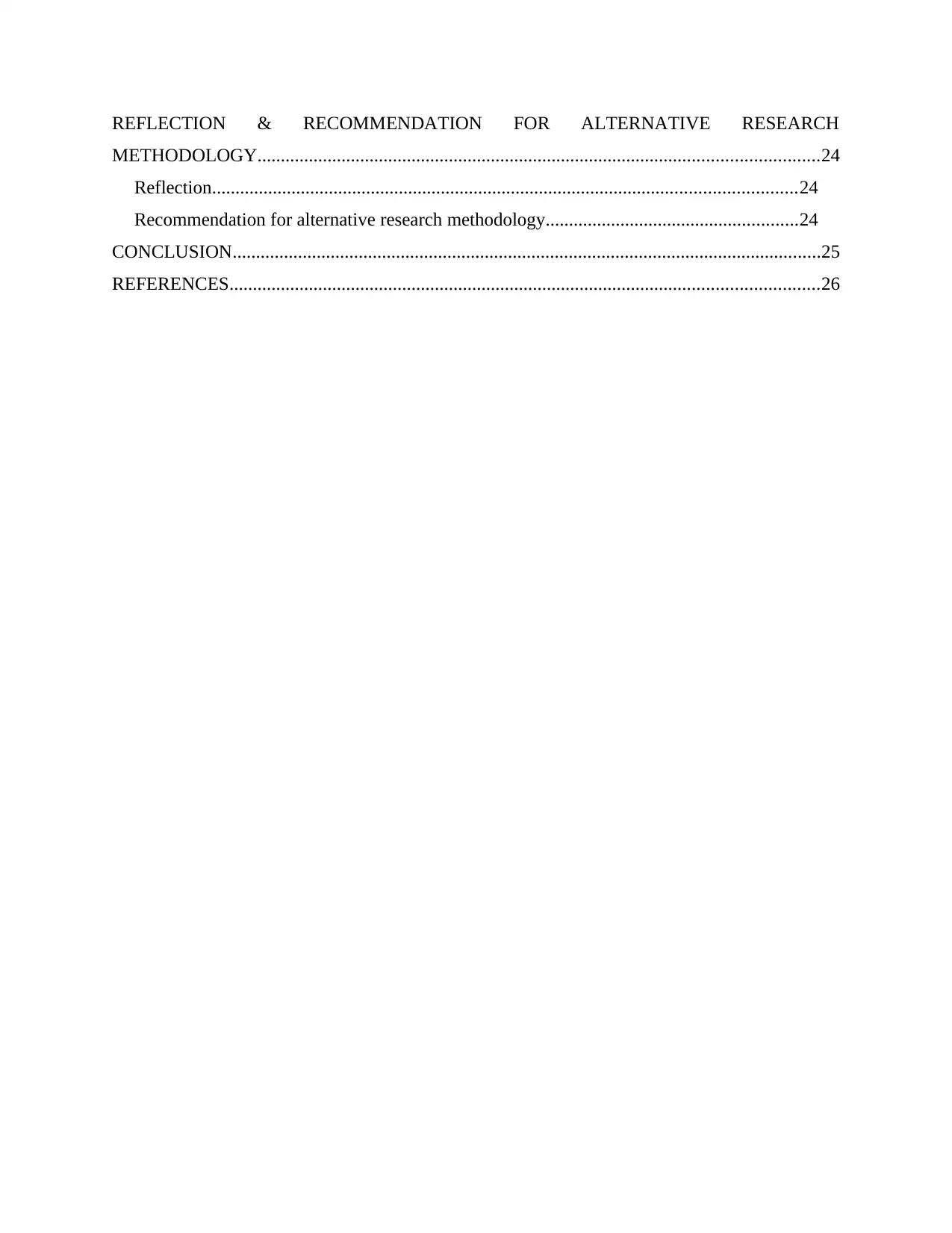
REFLECTION & RECOMMENDATION FOR ALTERNATIVE RESEARCH
METHODOLOGY........................................................................................................................24
Reflection.............................................................................................................................24
Recommendation for alternative research methodology......................................................24
CONCLUSION..............................................................................................................................25
REFERENCES..............................................................................................................................26
METHODOLOGY........................................................................................................................24
Reflection.............................................................................................................................24
Recommendation for alternative research methodology......................................................24
CONCLUSION..............................................................................................................................25
REFERENCES..............................................................................................................................26
⊘ This is a preview!⊘
Do you want full access?
Subscribe today to unlock all pages.

Trusted by 1+ million students worldwide
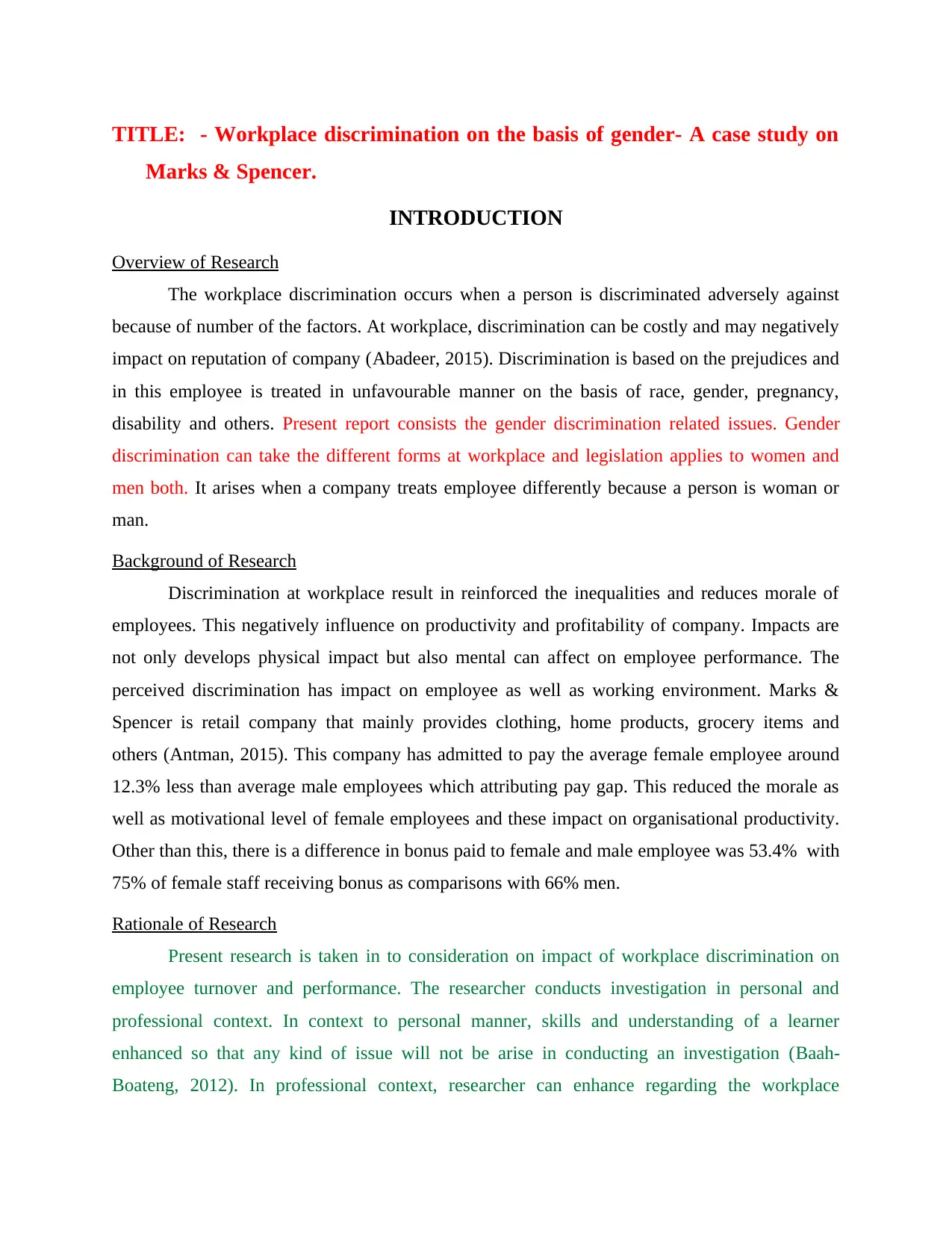
TITLE: - Workplace discrimination on the basis of gender- A case study on
Marks & Spencer.
INTRODUCTION
Overview of Research
The workplace discrimination occurs when a person is discriminated adversely against
because of number of the factors. At workplace, discrimination can be costly and may negatively
impact on reputation of company (Abadeer, 2015). Discrimination is based on the prejudices and
in this employee is treated in unfavourable manner on the basis of race, gender, pregnancy,
disability and others. Present report consists the gender discrimination related issues. Gender
discrimination can take the different forms at workplace and legislation applies to women and
men both. It arises when a company treats employee differently because a person is woman or
man.
Background of Research
Discrimination at workplace result in reinforced the inequalities and reduces morale of
employees. This negatively influence on productivity and profitability of company. Impacts are
not only develops physical impact but also mental can affect on employee performance. The
perceived discrimination has impact on employee as well as working environment. Marks &
Spencer is retail company that mainly provides clothing, home products, grocery items and
others (Antman, 2015). This company has admitted to pay the average female employee around
12.3% less than average male employees which attributing pay gap. This reduced the morale as
well as motivational level of female employees and these impact on organisational productivity.
Other than this, there is a difference in bonus paid to female and male employee was 53.4% with
75% of female staff receiving bonus as comparisons with 66% men.
Rationale of Research
Present research is taken in to consideration on impact of workplace discrimination on
employee turnover and performance. The researcher conducts investigation in personal and
professional context. In context to personal manner, skills and understanding of a learner
enhanced so that any kind of issue will not be arise in conducting an investigation (Baah-
Boateng, 2012). In professional context, researcher can enhance regarding the workplace
Marks & Spencer.
INTRODUCTION
Overview of Research
The workplace discrimination occurs when a person is discriminated adversely against
because of number of the factors. At workplace, discrimination can be costly and may negatively
impact on reputation of company (Abadeer, 2015). Discrimination is based on the prejudices and
in this employee is treated in unfavourable manner on the basis of race, gender, pregnancy,
disability and others. Present report consists the gender discrimination related issues. Gender
discrimination can take the different forms at workplace and legislation applies to women and
men both. It arises when a company treats employee differently because a person is woman or
man.
Background of Research
Discrimination at workplace result in reinforced the inequalities and reduces morale of
employees. This negatively influence on productivity and profitability of company. Impacts are
not only develops physical impact but also mental can affect on employee performance. The
perceived discrimination has impact on employee as well as working environment. Marks &
Spencer is retail company that mainly provides clothing, home products, grocery items and
others (Antman, 2015). This company has admitted to pay the average female employee around
12.3% less than average male employees which attributing pay gap. This reduced the morale as
well as motivational level of female employees and these impact on organisational productivity.
Other than this, there is a difference in bonus paid to female and male employee was 53.4% with
75% of female staff receiving bonus as comparisons with 66% men.
Rationale of Research
Present research is taken in to consideration on impact of workplace discrimination on
employee turnover and performance. The researcher conducts investigation in personal and
professional context. In context to personal manner, skills and understanding of a learner
enhanced so that any kind of issue will not be arise in conducting an investigation (Baah-
Boateng, 2012). In professional context, researcher can enhance regarding the workplace
Paraphrase This Document
Need a fresh take? Get an instant paraphrase of this document with our AI Paraphraser
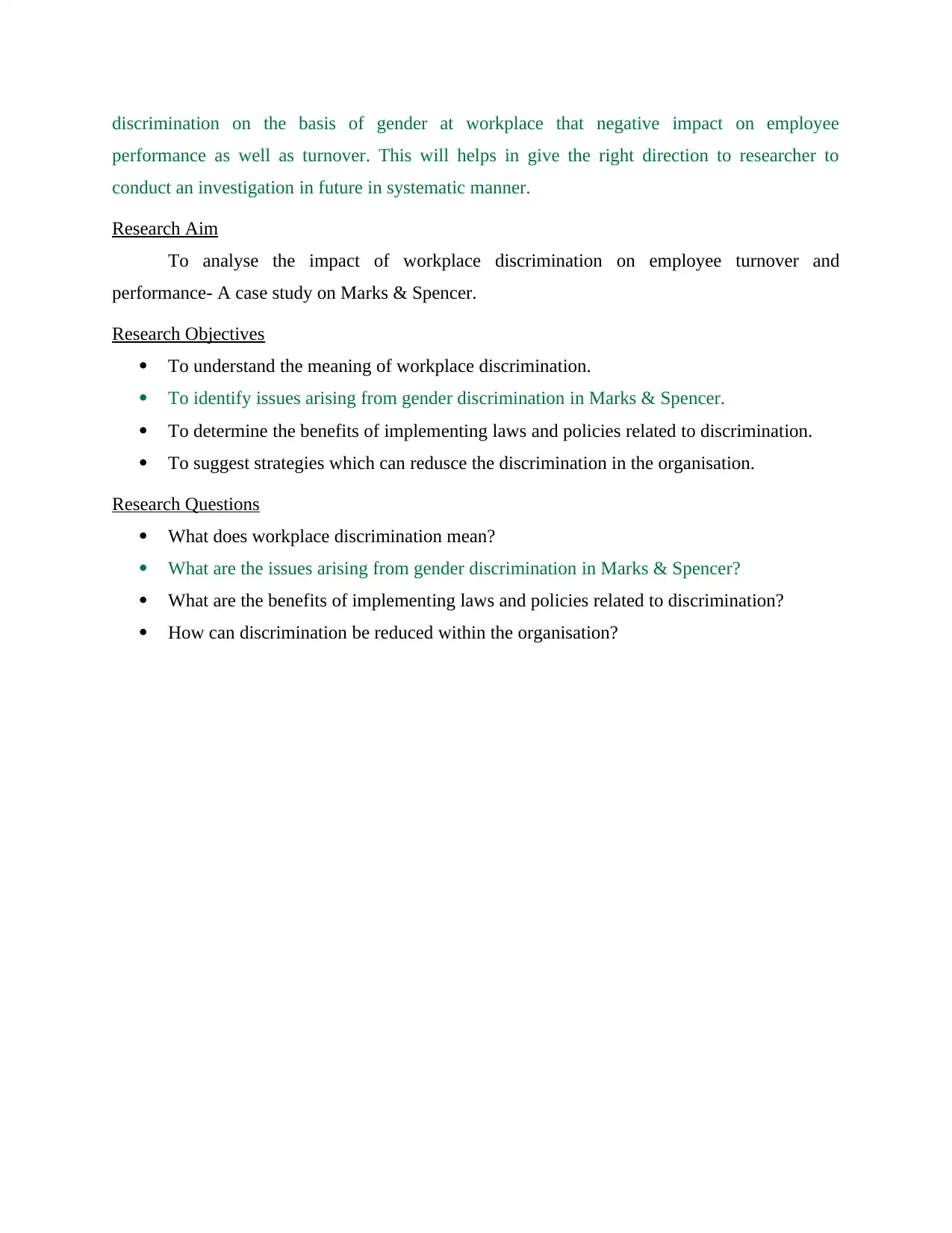
discrimination on the basis of gender at workplace that negative impact on employee
performance as well as turnover. This will helps in give the right direction to researcher to
conduct an investigation in future in systematic manner.
Research Aim
To analyse the impact of workplace discrimination on employee turnover and
performance- A case study on Marks & Spencer.
Research Objectives
To understand the meaning of workplace discrimination.
To identify issues arising from gender discrimination in Marks & Spencer.
To determine the benefits of implementing laws and policies related to discrimination.
To suggest strategies which can redusce the discrimination in the organisation.
Research Questions
What does workplace discrimination mean?
What are the issues arising from gender discrimination in Marks & Spencer?
What are the benefits of implementing laws and policies related to discrimination?
How can discrimination be reduced within the organisation?
performance as well as turnover. This will helps in give the right direction to researcher to
conduct an investigation in future in systematic manner.
Research Aim
To analyse the impact of workplace discrimination on employee turnover and
performance- A case study on Marks & Spencer.
Research Objectives
To understand the meaning of workplace discrimination.
To identify issues arising from gender discrimination in Marks & Spencer.
To determine the benefits of implementing laws and policies related to discrimination.
To suggest strategies which can redusce the discrimination in the organisation.
Research Questions
What does workplace discrimination mean?
What are the issues arising from gender discrimination in Marks & Spencer?
What are the benefits of implementing laws and policies related to discrimination?
How can discrimination be reduced within the organisation?
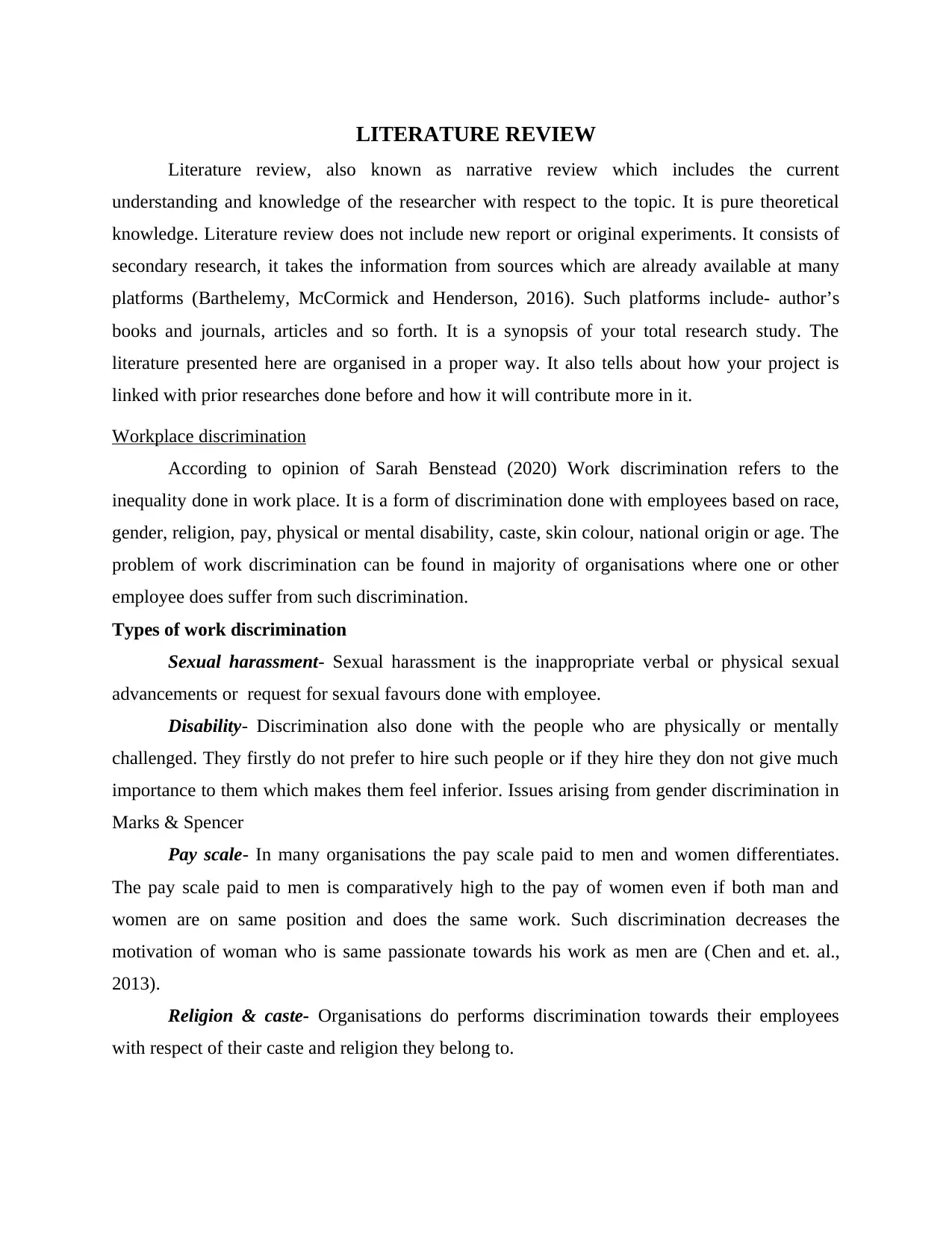
LITERATURE REVIEW
Literature review, also known as narrative review which includes the current
understanding and knowledge of the researcher with respect to the topic. It is pure theoretical
knowledge. Literature review does not include new report or original experiments. It consists of
secondary research, it takes the information from sources which are already available at many
platforms (Barthelemy, McCormick and Henderson, 2016). Such platforms include- author’s
books and journals, articles and so forth. It is a synopsis of your total research study. The
literature presented here are organised in a proper way. It also tells about how your project is
linked with prior researches done before and how it will contribute more in it.
Workplace discrimination
According to opinion of Sarah Benstead (2020) Work discrimination refers to the
inequality done in work place. It is a form of discrimination done with employees based on race,
gender, religion, pay, physical or mental disability, caste, skin colour, national origin or age. The
problem of work discrimination can be found in majority of organisations where one or other
employee does suffer from such discrimination.
Types of work discrimination
Sexual harassment- Sexual harassment is the inappropriate verbal or physical sexual
advancements or request for sexual favours done with employee.
Disability- Discrimination also done with the people who are physically or mentally
challenged. They firstly do not prefer to hire such people or if they hire they don not give much
importance to them which makes them feel inferior. Issues arising from gender discrimination in
Marks & Spencer
Pay scale- In many organisations the pay scale paid to men and women differentiates.
The pay scale paid to men is comparatively high to the pay of women even if both man and
women are on same position and does the same work. Such discrimination decreases the
motivation of woman who is same passionate towards his work as men are (Chen and et. al.,
2013).
Religion & caste- Organisations do performs discrimination towards their employees
with respect of their caste and religion they belong to.
Literature review, also known as narrative review which includes the current
understanding and knowledge of the researcher with respect to the topic. It is pure theoretical
knowledge. Literature review does not include new report or original experiments. It consists of
secondary research, it takes the information from sources which are already available at many
platforms (Barthelemy, McCormick and Henderson, 2016). Such platforms include- author’s
books and journals, articles and so forth. It is a synopsis of your total research study. The
literature presented here are organised in a proper way. It also tells about how your project is
linked with prior researches done before and how it will contribute more in it.
Workplace discrimination
According to opinion of Sarah Benstead (2020) Work discrimination refers to the
inequality done in work place. It is a form of discrimination done with employees based on race,
gender, religion, pay, physical or mental disability, caste, skin colour, national origin or age. The
problem of work discrimination can be found in majority of organisations where one or other
employee does suffer from such discrimination.
Types of work discrimination
Sexual harassment- Sexual harassment is the inappropriate verbal or physical sexual
advancements or request for sexual favours done with employee.
Disability- Discrimination also done with the people who are physically or mentally
challenged. They firstly do not prefer to hire such people or if they hire they don not give much
importance to them which makes them feel inferior. Issues arising from gender discrimination in
Marks & Spencer
Pay scale- In many organisations the pay scale paid to men and women differentiates.
The pay scale paid to men is comparatively high to the pay of women even if both man and
women are on same position and does the same work. Such discrimination decreases the
motivation of woman who is same passionate towards his work as men are (Chen and et. al.,
2013).
Religion & caste- Organisations do performs discrimination towards their employees
with respect of their caste and religion they belong to.
⊘ This is a preview!⊘
Do you want full access?
Subscribe today to unlock all pages.

Trusted by 1+ million students worldwide
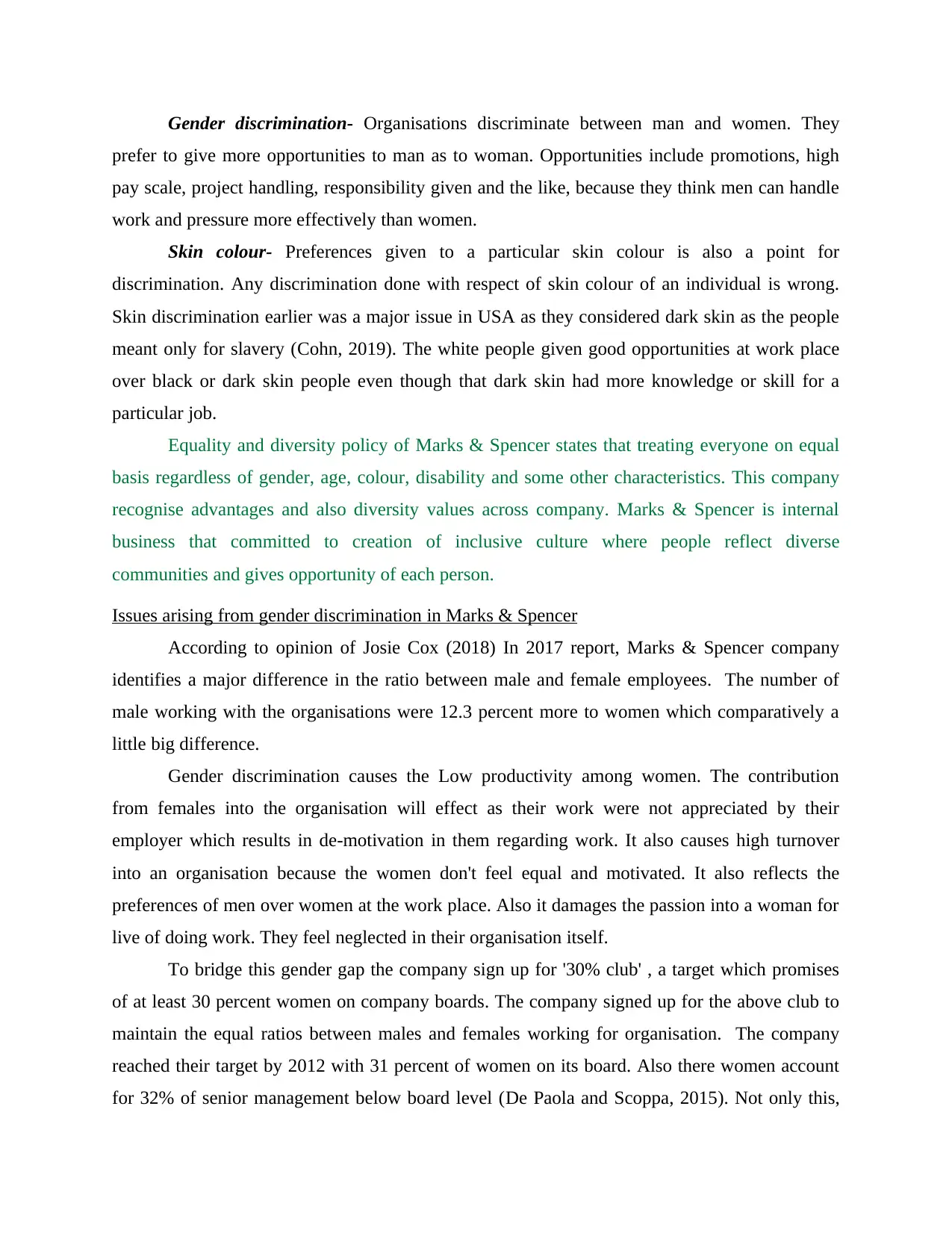
Gender discrimination- Organisations discriminate between man and women. They
prefer to give more opportunities to man as to woman. Opportunities include promotions, high
pay scale, project handling, responsibility given and the like, because they think men can handle
work and pressure more effectively than women.
Skin colour- Preferences given to a particular skin colour is also a point for
discrimination. Any discrimination done with respect of skin colour of an individual is wrong.
Skin discrimination earlier was a major issue in USA as they considered dark skin as the people
meant only for slavery (Cohn, 2019). The white people given good opportunities at work place
over black or dark skin people even though that dark skin had more knowledge or skill for a
particular job.
Equality and diversity policy of Marks & Spencer states that treating everyone on equal
basis regardless of gender, age, colour, disability and some other characteristics. This company
recognise advantages and also diversity values across company. Marks & Spencer is internal
business that committed to creation of inclusive culture where people reflect diverse
communities and gives opportunity of each person.
Issues arising from gender discrimination in Marks & Spencer
According to opinion of Josie Cox (2018) In 2017 report, Marks & Spencer company
identifies a major difference in the ratio between male and female employees. The number of
male working with the organisations were 12.3 percent more to women which comparatively a
little big difference.
Gender discrimination causes the Low productivity among women. The contribution
from females into the organisation will effect as their work were not appreciated by their
employer which results in de-motivation in them regarding work. It also causes high turnover
into an organisation because the women don't feel equal and motivated. It also reflects the
preferences of men over women at the work place. Also it damages the passion into a woman for
live of doing work. They feel neglected in their organisation itself.
To bridge this gender gap the company sign up for '30% club' , a target which promises
of at least 30 percent women on company boards. The company signed up for the above club to
maintain the equal ratios between males and females working for organisation. The company
reached their target by 2012 with 31 percent of women on its board. Also there women account
for 32% of senior management below board level (De Paola and Scoppa, 2015). Not only this,
prefer to give more opportunities to man as to woman. Opportunities include promotions, high
pay scale, project handling, responsibility given and the like, because they think men can handle
work and pressure more effectively than women.
Skin colour- Preferences given to a particular skin colour is also a point for
discrimination. Any discrimination done with respect of skin colour of an individual is wrong.
Skin discrimination earlier was a major issue in USA as they considered dark skin as the people
meant only for slavery (Cohn, 2019). The white people given good opportunities at work place
over black or dark skin people even though that dark skin had more knowledge or skill for a
particular job.
Equality and diversity policy of Marks & Spencer states that treating everyone on equal
basis regardless of gender, age, colour, disability and some other characteristics. This company
recognise advantages and also diversity values across company. Marks & Spencer is internal
business that committed to creation of inclusive culture where people reflect diverse
communities and gives opportunity of each person.
Issues arising from gender discrimination in Marks & Spencer
According to opinion of Josie Cox (2018) In 2017 report, Marks & Spencer company
identifies a major difference in the ratio between male and female employees. The number of
male working with the organisations were 12.3 percent more to women which comparatively a
little big difference.
Gender discrimination causes the Low productivity among women. The contribution
from females into the organisation will effect as their work were not appreciated by their
employer which results in de-motivation in them regarding work. It also causes high turnover
into an organisation because the women don't feel equal and motivated. It also reflects the
preferences of men over women at the work place. Also it damages the passion into a woman for
live of doing work. They feel neglected in their organisation itself.
To bridge this gender gap the company sign up for '30% club' , a target which promises
of at least 30 percent women on company boards. The company signed up for the above club to
maintain the equal ratios between males and females working for organisation. The company
reached their target by 2012 with 31 percent of women on its board. Also there women account
for 32% of senior management below board level (De Paola and Scoppa, 2015). Not only this,
Paraphrase This Document
Need a fresh take? Get an instant paraphrase of this document with our AI Paraphraser
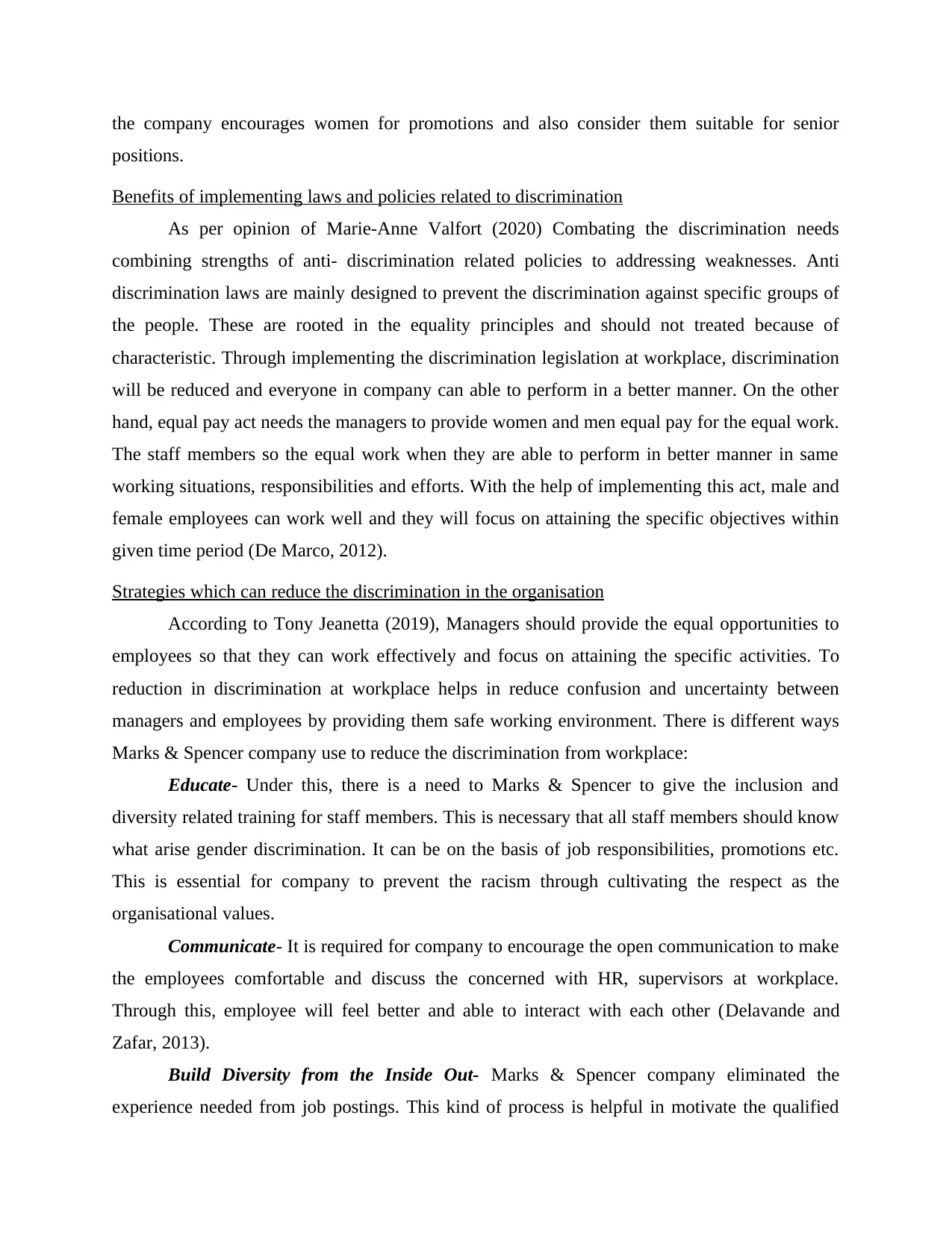
the company encourages women for promotions and also consider them suitable for senior
positions.
Benefits of implementing laws and policies related to discrimination
As per opinion of Marie-Anne Valfort (2020) Combating the discrimination needs
combining strengths of anti- discrimination related policies to addressing weaknesses. Anti
discrimination laws are mainly designed to prevent the discrimination against specific groups of
the people. These are rooted in the equality principles and should not treated because of
characteristic. Through implementing the discrimination legislation at workplace, discrimination
will be reduced and everyone in company can able to perform in a better manner. On the other
hand, equal pay act needs the managers to provide women and men equal pay for the equal work.
The staff members so the equal work when they are able to perform in better manner in same
working situations, responsibilities and efforts. With the help of implementing this act, male and
female employees can work well and they will focus on attaining the specific objectives within
given time period (De Marco, 2012).
Strategies which can reduce the discrimination in the organisation
According to Tony Jeanetta (2019), Managers should provide the equal opportunities to
employees so that they can work effectively and focus on attaining the specific activities. To
reduction in discrimination at workplace helps in reduce confusion and uncertainty between
managers and employees by providing them safe working environment. There is different ways
Marks & Spencer company use to reduce the discrimination from workplace:
Educate- Under this, there is a need to Marks & Spencer to give the inclusion and
diversity related training for staff members. This is necessary that all staff members should know
what arise gender discrimination. It can be on the basis of job responsibilities, promotions etc.
This is essential for company to prevent the racism through cultivating the respect as the
organisational values.
Communicate- It is required for company to encourage the open communication to make
the employees comfortable and discuss the concerned with HR, supervisors at workplace.
Through this, employee will feel better and able to interact with each other (Delavande and
Zafar, 2013).
Build Diversity from the Inside Out- Marks & Spencer company eliminated the
experience needed from job postings. This kind of process is helpful in motivate the qualified
positions.
Benefits of implementing laws and policies related to discrimination
As per opinion of Marie-Anne Valfort (2020) Combating the discrimination needs
combining strengths of anti- discrimination related policies to addressing weaknesses. Anti
discrimination laws are mainly designed to prevent the discrimination against specific groups of
the people. These are rooted in the equality principles and should not treated because of
characteristic. Through implementing the discrimination legislation at workplace, discrimination
will be reduced and everyone in company can able to perform in a better manner. On the other
hand, equal pay act needs the managers to provide women and men equal pay for the equal work.
The staff members so the equal work when they are able to perform in better manner in same
working situations, responsibilities and efforts. With the help of implementing this act, male and
female employees can work well and they will focus on attaining the specific objectives within
given time period (De Marco, 2012).
Strategies which can reduce the discrimination in the organisation
According to Tony Jeanetta (2019), Managers should provide the equal opportunities to
employees so that they can work effectively and focus on attaining the specific activities. To
reduction in discrimination at workplace helps in reduce confusion and uncertainty between
managers and employees by providing them safe working environment. There is different ways
Marks & Spencer company use to reduce the discrimination from workplace:
Educate- Under this, there is a need to Marks & Spencer to give the inclusion and
diversity related training for staff members. This is necessary that all staff members should know
what arise gender discrimination. It can be on the basis of job responsibilities, promotions etc.
This is essential for company to prevent the racism through cultivating the respect as the
organisational values.
Communicate- It is required for company to encourage the open communication to make
the employees comfortable and discuss the concerned with HR, supervisors at workplace.
Through this, employee will feel better and able to interact with each other (Delavande and
Zafar, 2013).
Build Diversity from the Inside Out- Marks & Spencer company eliminated the
experience needed from job postings. This kind of process is helpful in motivate the qualified

female employees to be applied so that the working environment can be developed properly and
each one can work in significant manner.
each one can work in significant manner.
⊘ This is a preview!⊘
Do you want full access?
Subscribe today to unlock all pages.

Trusted by 1+ million students worldwide

RESEARCH METHODOLOGY
Research methodology is the procedure a researcher has followed with respect to data
collection. It tells the reader about how the data has been collected or generated. It also describes
the approaches and design which has been used majorly in the study. Research methodology tells
a reader about how the study has been conducted, what sources of information he used, and how
the study has been perceived (Kumar, 2019).
Type of Investigation
In conducting the present investigation, qualitative method has been used because it
analyse the collected data effectively so that the researcher can able to getting the positive
outcomes.
Different research methods are mention below-
Qualitative method- It is a research method where the data is gathered through
observation and self-conduct research. In this type of data the information collected is qualitative
in nature i.e. they are expressed in non-numerical terms. From this method generally the
behaviour and perception of target group is perceived. If the researcher wants to know about the
taste, preferences, attitude, stimuli and the like of his target audience about a particular topic then
this method is used (Hennink, Hutter and Bailey, 2020). Some commonly used primary method
of research includes observation, interview, experiments, surveys etc.
Quantitative method- Under this, information and data are gathered in numerical form.
All the information and data are quantifiable. The data which is gathered then get organized and
analysis takes place to take out meaning interpretation from them. Such interpretation helps the
investigator in getting to a conclusion (Bernard, 2017).
Research philosophy
In present research, interpretivism philosophy has been used because this helps in analyse
opinions and viewpoints of different investigators. This philosophy is helpful in getting detailed
information and providing positive outcomes (Cazeaux, 2017).
This is explained as the beliefs and belief framework about knowledge development. The
conceptual methods make it possible to assess which philosophy should be pursued by a
Research methodology is the procedure a researcher has followed with respect to data
collection. It tells the reader about how the data has been collected or generated. It also describes
the approaches and design which has been used majorly in the study. Research methodology tells
a reader about how the study has been conducted, what sources of information he used, and how
the study has been perceived (Kumar, 2019).
Type of Investigation
In conducting the present investigation, qualitative method has been used because it
analyse the collected data effectively so that the researcher can able to getting the positive
outcomes.
Different research methods are mention below-
Qualitative method- It is a research method where the data is gathered through
observation and self-conduct research. In this type of data the information collected is qualitative
in nature i.e. they are expressed in non-numerical terms. From this method generally the
behaviour and perception of target group is perceived. If the researcher wants to know about the
taste, preferences, attitude, stimuli and the like of his target audience about a particular topic then
this method is used (Hennink, Hutter and Bailey, 2020). Some commonly used primary method
of research includes observation, interview, experiments, surveys etc.
Quantitative method- Under this, information and data are gathered in numerical form.
All the information and data are quantifiable. The data which is gathered then get organized and
analysis takes place to take out meaning interpretation from them. Such interpretation helps the
investigator in getting to a conclusion (Bernard, 2017).
Research philosophy
In present research, interpretivism philosophy has been used because this helps in analyse
opinions and viewpoints of different investigators. This philosophy is helpful in getting detailed
information and providing positive outcomes (Cazeaux, 2017).
This is explained as the beliefs and belief framework about knowledge development. The
conceptual methods make it possible to assess which philosophy should be pursued by a
Paraphrase This Document
Need a fresh take? Get an instant paraphrase of this document with our AI Paraphraser
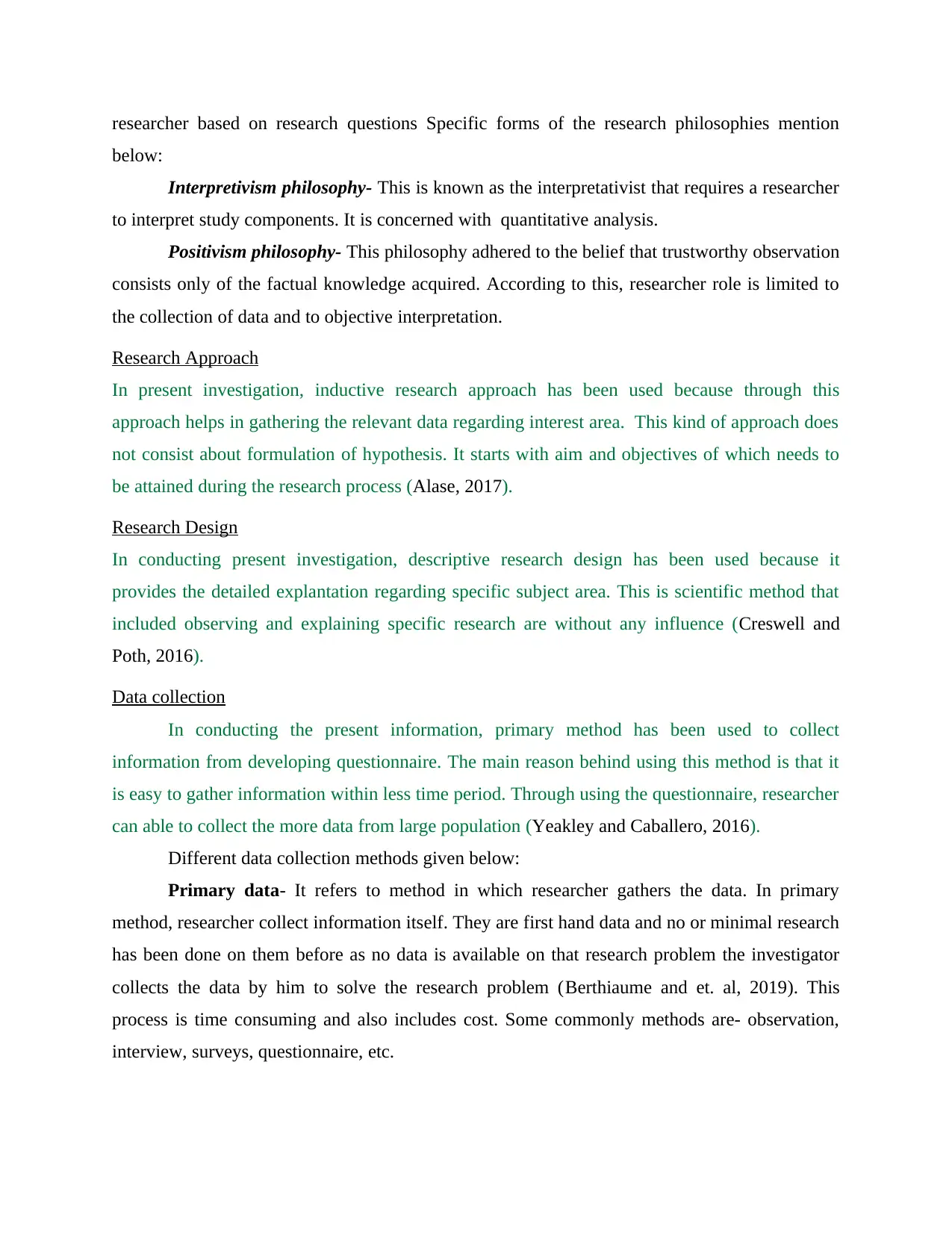
researcher based on research questions Specific forms of the research philosophies mention
below:
Interpretivism philosophy- This is known as the interpretativist that requires a researcher
to interpret study components. It is concerned with quantitative analysis.
Positivism philosophy- This philosophy adhered to the belief that trustworthy observation
consists only of the factual knowledge acquired. According to this, researcher role is limited to
the collection of data and to objective interpretation.
Research Approach
In present investigation, inductive research approach has been used because through this
approach helps in gathering the relevant data regarding interest area. This kind of approach does
not consist about formulation of hypothesis. It starts with aim and objectives of which needs to
be attained during the research process (Alase, 2017).
Research Design
In conducting present investigation, descriptive research design has been used because it
provides the detailed explantation regarding specific subject area. This is scientific method that
included observing and explaining specific research are without any influence (Creswell and
Poth, 2016).
Data collection
In conducting the present information, primary method has been used to collect
information from developing questionnaire. The main reason behind using this method is that it
is easy to gather information within less time period. Through using the questionnaire, researcher
can able to collect the more data from large population (Yeakley and Caballero, 2016).
Different data collection methods given below:
Primary data- It refers to method in which researcher gathers the data. In primary
method, researcher collect information itself. They are first hand data and no or minimal research
has been done on them before as no data is available on that research problem the investigator
collects the data by him to solve the research problem (Berthiaume and et. al, 2019). This
process is time consuming and also includes cost. Some commonly methods are- observation,
interview, surveys, questionnaire, etc.
below:
Interpretivism philosophy- This is known as the interpretativist that requires a researcher
to interpret study components. It is concerned with quantitative analysis.
Positivism philosophy- This philosophy adhered to the belief that trustworthy observation
consists only of the factual knowledge acquired. According to this, researcher role is limited to
the collection of data and to objective interpretation.
Research Approach
In present investigation, inductive research approach has been used because through this
approach helps in gathering the relevant data regarding interest area. This kind of approach does
not consist about formulation of hypothesis. It starts with aim and objectives of which needs to
be attained during the research process (Alase, 2017).
Research Design
In conducting present investigation, descriptive research design has been used because it
provides the detailed explantation regarding specific subject area. This is scientific method that
included observing and explaining specific research are without any influence (Creswell and
Poth, 2016).
Data collection
In conducting the present information, primary method has been used to collect
information from developing questionnaire. The main reason behind using this method is that it
is easy to gather information within less time period. Through using the questionnaire, researcher
can able to collect the more data from large population (Yeakley and Caballero, 2016).
Different data collection methods given below:
Primary data- It refers to method in which researcher gathers the data. In primary
method, researcher collect information itself. They are first hand data and no or minimal research
has been done on them before as no data is available on that research problem the investigator
collects the data by him to solve the research problem (Berthiaume and et. al, 2019). This
process is time consuming and also includes cost. Some commonly methods are- observation,
interview, surveys, questionnaire, etc.
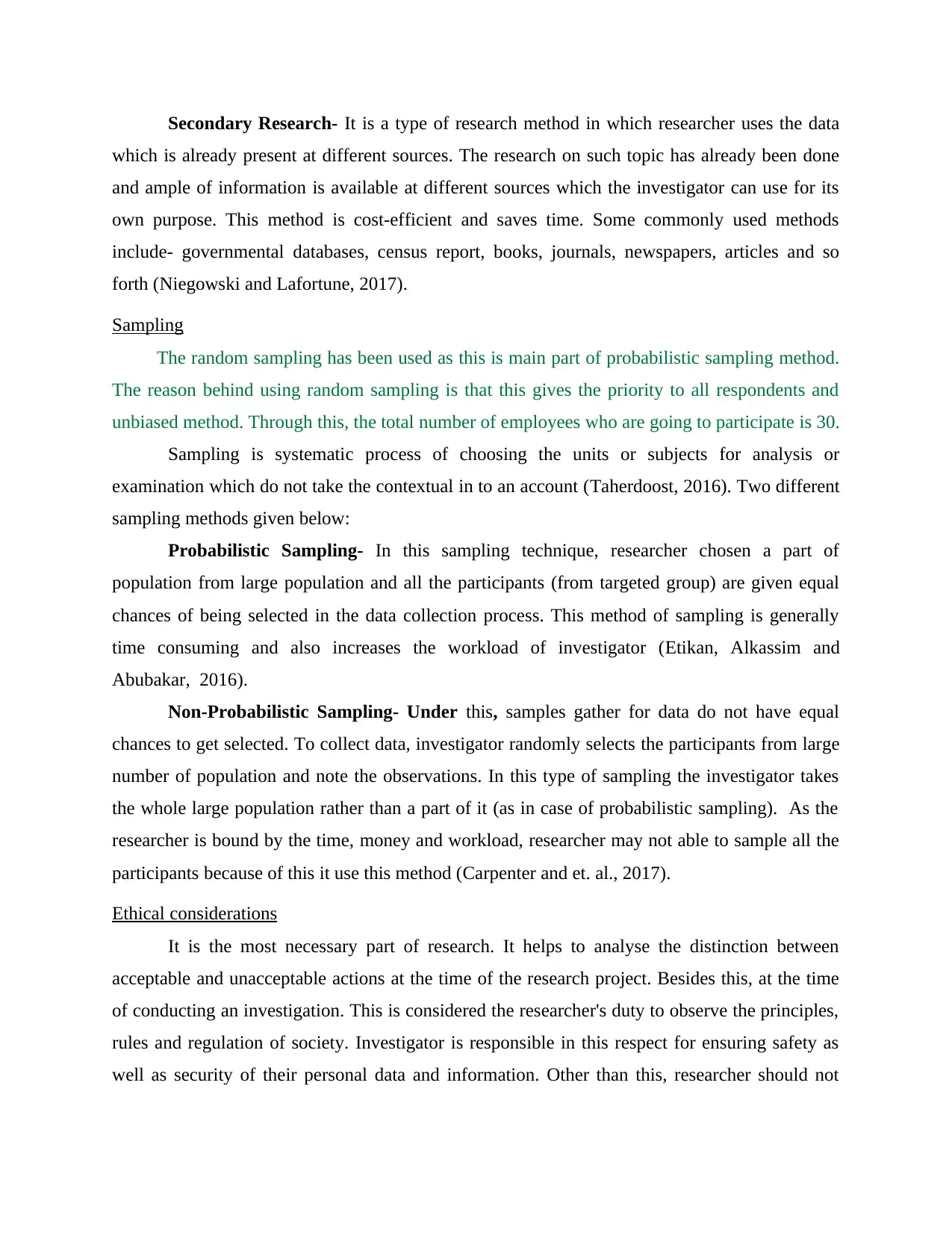
Secondary Research- It is a type of research method in which researcher uses the data
which is already present at different sources. The research on such topic has already been done
and ample of information is available at different sources which the investigator can use for its
own purpose. This method is cost-efficient and saves time. Some commonly used methods
include- governmental databases, census report, books, journals, newspapers, articles and so
forth (Niegowski and Lafortune, 2017).
Sampling
The random sampling has been used as this is main part of probabilistic sampling method.
The reason behind using random sampling is that this gives the priority to all respondents and
unbiased method. Through this, the total number of employees who are going to participate is 30.
Sampling is systematic process of choosing the units or subjects for analysis or
examination which do not take the contextual in to an account (Taherdoost, 2016). Two different
sampling methods given below:
Probabilistic Sampling- In this sampling technique, researcher chosen a part of
population from large population and all the participants (from targeted group) are given equal
chances of being selected in the data collection process. This method of sampling is generally
time consuming and also increases the workload of investigator (Etikan, Alkassim and
Abubakar, 2016).
Non-Probabilistic Sampling- Under this, samples gather for data do not have equal
chances to get selected. To collect data, investigator randomly selects the participants from large
number of population and note the observations. In this type of sampling the investigator takes
the whole large population rather than a part of it (as in case of probabilistic sampling). As the
researcher is bound by the time, money and workload, researcher may not able to sample all the
participants because of this it use this method (Carpenter and et. al., 2017).
Ethical considerations
It is the most necessary part of research. It helps to analyse the distinction between
acceptable and unacceptable actions at the time of the research project. Besides this, at the time
of conducting an investigation. This is considered the researcher's duty to observe the principles,
rules and regulation of society. Investigator is responsible in this respect for ensuring safety as
well as security of their personal data and information. Other than this, researcher should not
which is already present at different sources. The research on such topic has already been done
and ample of information is available at different sources which the investigator can use for its
own purpose. This method is cost-efficient and saves time. Some commonly used methods
include- governmental databases, census report, books, journals, newspapers, articles and so
forth (Niegowski and Lafortune, 2017).
Sampling
The random sampling has been used as this is main part of probabilistic sampling method.
The reason behind using random sampling is that this gives the priority to all respondents and
unbiased method. Through this, the total number of employees who are going to participate is 30.
Sampling is systematic process of choosing the units or subjects for analysis or
examination which do not take the contextual in to an account (Taherdoost, 2016). Two different
sampling methods given below:
Probabilistic Sampling- In this sampling technique, researcher chosen a part of
population from large population and all the participants (from targeted group) are given equal
chances of being selected in the data collection process. This method of sampling is generally
time consuming and also increases the workload of investigator (Etikan, Alkassim and
Abubakar, 2016).
Non-Probabilistic Sampling- Under this, samples gather for data do not have equal
chances to get selected. To collect data, investigator randomly selects the participants from large
number of population and note the observations. In this type of sampling the investigator takes
the whole large population rather than a part of it (as in case of probabilistic sampling). As the
researcher is bound by the time, money and workload, researcher may not able to sample all the
participants because of this it use this method (Carpenter and et. al., 2017).
Ethical considerations
It is the most necessary part of research. It helps to analyse the distinction between
acceptable and unacceptable actions at the time of the research project. Besides this, at the time
of conducting an investigation. This is considered the researcher's duty to observe the principles,
rules and regulation of society. Investigator is responsible in this respect for ensuring safety as
well as security of their personal data and information. Other than this, researcher should not
⊘ This is a preview!⊘
Do you want full access?
Subscribe today to unlock all pages.

Trusted by 1+ million students worldwide
1 out of 33
Related Documents
Your All-in-One AI-Powered Toolkit for Academic Success.
+13062052269
info@desklib.com
Available 24*7 on WhatsApp / Email
![[object Object]](/_next/static/media/star-bottom.7253800d.svg)
Unlock your academic potential
Copyright © 2020–2025 A2Z Services. All Rights Reserved. Developed and managed by ZUCOL.




